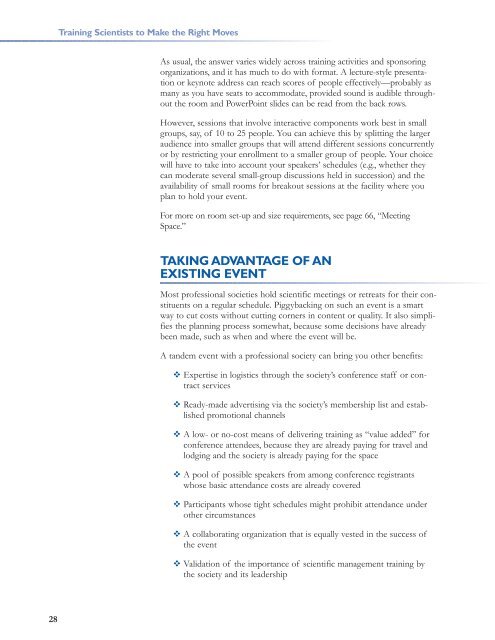Training Scientists to Make the Right Moves - Howard Hughes ...
Training Scientists to Make the Right Moves - Howard Hughes ...
Training Scientists to Make the Right Moves - Howard Hughes ...
You also want an ePaper? Increase the reach of your titles
YUMPU automatically turns print PDFs into web optimized ePapers that Google loves.
<strong>Training</strong> <strong>Scientists</strong> <strong>to</strong> <strong>Make</strong> <strong>the</strong> <strong>Right</strong> <strong>Moves</strong><br />
As usual, <strong>the</strong> answer varies widely across training activities and sponsoring<br />
organizations, and it has much <strong>to</strong> do with format. A lecture-style presentation<br />
or keynote address can reach scores of people effectively—probably as<br />
many as you have seats <strong>to</strong> accommodate, provided sound is audible throughout<br />
<strong>the</strong> room and PowerPoint slides can be read from <strong>the</strong> back rows.<br />
However, sessions that involve interactive components work best in small<br />
groups, say, of 10 <strong>to</strong> 25 people. You can achieve this by splitting <strong>the</strong> larger<br />
audience in<strong>to</strong> smaller groups that will attend different sessions concurrently<br />
or by restricting your enrollment <strong>to</strong> a smaller group of people. Your choice<br />
will have <strong>to</strong> take in<strong>to</strong> account your speakers’ schedules (e.g., whe<strong>the</strong>r <strong>the</strong>y<br />
can moderate several small-group discussions held in succession) and <strong>the</strong><br />
availability of small rooms for breakout sessions at <strong>the</strong> facility where you<br />
plan <strong>to</strong> hold your event.<br />
For more on room set-up and size requirements, see page 66, “Meeting<br />
Space.”<br />
TAKING ADVANTAGE OF AN<br />
EXISTING EVENT<br />
Most professional societies hold scientific meetings or retreats for <strong>the</strong>ir constituents<br />
on a regular schedule. Piggybacking on such an event is a smart<br />
way <strong>to</strong> cut costs without cutting corners in content or quality. It also simplifies<br />
<strong>the</strong> planning process somewhat, because some decisions have already<br />
been made, such as when and where <strong>the</strong> event will be.<br />
A tandem event with a professional society can bring you o<strong>the</strong>r benefits:<br />
Expertise in logistics through <strong>the</strong> society’s conference staff or contract<br />
services<br />
Ready-made advertising via <strong>the</strong> society’s membership list and established<br />
promotional channels<br />
A low- or no-cost means of delivering training as “value added” for<br />
conference attendees, because <strong>the</strong>y are already paying for travel and<br />
lodging and <strong>the</strong> society is already paying for <strong>the</strong> space<br />
A pool of possible speakers from among conference registrants<br />
whose basic attendance costs are already covered<br />
Participants whose tight schedules might prohibit attendance under<br />
o<strong>the</strong>r circumstances<br />
A collaborating organization that is equally vested in <strong>the</strong> success of<br />
<strong>the</strong> event<br />
Validation of <strong>the</strong> importance of scientific management training by<br />
<strong>the</strong> society and its leadership<br />
28
















